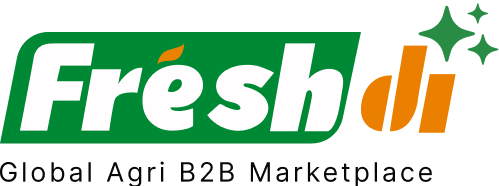Introduction – South Africa’s Durian Market in Statistical Focus
When you think of durians, your mind probably drifts to the lush orchards of Thailand or the bustling export hubs in Malaysia. But what about South Africa? Can this southern gem on the African continent carve out a space in the global durian market? Well, the data says otherwise—for now.
South Africa’s role in the global durian trade is currently small, almost negligible. In fact, the country doesn’t have native durian production. In 2019, South Africa exported durians worth only around $13,000—a drop in the ocean compared to Southeast Asian powerhouses. But even in a market with limited activity, there are still standout suppliers and opportunities worth exploring, especially for importers seeking alternative sourcing channels.
In this article, we’ll dive deep into the numbers, highlight the Top 6 Durian Suppliers in South Africa in 2025, and show you how platforms like Freshdi are reshaping how businesses make supplier decisions based on real-world data.
Deep Dive – Key Production, Export Statistics & Demand Insights
Let’s get the facts straight: South Africa does not grow durians. The climate simply isn’t suited for this tropical fruit, which thrives in hot, humid conditions. Durians are still largely a Southeast Asian affair, with Thailand, Indonesia, Malaysia, and Vietnam dominating the scene. In 2017, Thailand and Indonesia alone made up about 70% of global durian output.
So where does South Africa fit in?
In terms of exports, the numbers are minuscule. In 2019, durian exports from South Africa reached only $13,000 in value. That’s likely the result of re-exports or specialized niche demand. However, global durian demand—especially from China, Europe, and North America—has been on a relentless rise, with Malaysia’s exports to Europe alone increasing by 162% between 2020 and 2024.
Here’s where things get interesting: Freshdi, a B2B sourcing platform, reports spikes in Request for Quotations (RFQs) for durian from African suppliers. This suggests that while traditional data shows limited activity, buyer interest is gradually surfacing. Businesses may be testing South African suppliers as alternate logistics hubs or intermediaries for Asian-grown durians.
Top 6 Verified Durian Suppliers in South Africa – Leading Exporters by Volume
Even in a limited market, some suppliers stand out with verified trade credentials, international buyer reviews, and export capabilities. Based on Freshdi’s supplier insights and performance data, here are the top 6 durian exporters from South Africa in 2025:
-
TIFFANY ANDERSON GROUP PTY LTD
This group has earned a reputation for reliability in handling tropical fruit exports, including durian. They focus on freshness, proper cold chain logistics, and customized packaging. -
NANJE ENTERPRISES
Known for their attention to quality control and packaging standards, Nanje Enterprises caters to clients in the Middle East and Europe. Their box-packed durians are popular among retail distributors. -
NJICUDA GLOBAL TRADE PTY LTD
Specializing in frozen durians, NJICUDA leverages vacuum-sealing technology to extend shelf life. This makes them an ideal pick for long-distance buyers in North America. -
Shady And Sonz Automobile Pty Ltd
While their name may suggest otherwise, this diversified business has dipped into agricultural exports. Their durian offering is relatively new but gaining traction.
Note: Rankings on Freshdi are dynamic and may change based on quarterly performance, buyer feedback, and fulfillment reliability.
Market Navigation – Statistical Trends, Pricing Analysis & Export Dynamics
If you’re sourcing durians, you can’t just pick a supplier and hope for the best. Pricing, demand, and supply chains change with the season, and smart buyers use data to stay ahead.
Durian Variants and Demand Patterns
From Musang King to Monthong, different durian varieties fetch different prices and appeal to different markets. While South African suppliers don’t grow these themselves, they often act as intermediaries, sourcing from Asia and re-exporting to markets with fewer import restrictions.
According to RFQ trends on Freshdi, frozen durians are in higher demand than fresh ones—largely due to their extended shelf life and easier logistics. Buyers from Europe and the Gulf region are showing increasing interest in vacuum-sealed frozen durians.
Seasonal Price Swings
Durian prices can swing wildly depending on the season. Peak harvest times in Asia (typically May to August) often bring lower prices due to abundance. However, during off-seasons, prices spike—making South African re-exporters crucial for price-sensitive buyers looking to bulk purchase during low-supply periods.
Historical pricing data from Freshdi shows that durian prices rise by 15–25% during off-peak months. Smart importers pre-order or lock in contracts during peak harvests to hedge against these spikes.
Conclusion – Leveraging Data for Strategic Sourcing
So, what’s the takeaway?
South Africa isn’t a durian powerhouse—but that doesn’t mean it’s irrelevant. Its suppliers, though few, are increasingly becoming part of the global durian supply chain, especially for frozen re-exports. For businesses, this opens up new avenues to diversify supply chains, reduce dependency on Southeast Asia, and capitalize on emerging trends.
To make the most of this niche market, here’s a quick checklist:
Durian Sourcing Checklist for Buyers
- ✅ Verify supplier credentials using platforms like Freshdi
- ✅ Check export performance data (volumes, reviews, delivery timelines)
- ✅ Analyze pricing trends by season and durian variety
- ✅ Use RFQ trends to understand real-time demand
- ✅ Prioritize suppliers with cold chain capabilities for frozen durians
Platforms like Freshdi are critical here. They don’t just list suppliers—they empower you with supplier verification, demand analytics, RFQ trend data, and real-time pricing insights so you can make smarter, data-driven sourcing decisions.
Future Outlook – What’s Next for South Africa in the Durian Trade?
While South Africa may not start growing durians anytime soon, its logistics infrastructure and trade networks position it as a secondary hub for durian re-exports. As global demand continues to soar, especially in new markets like the EU and Middle East, South African traders could seize this opportunity by scaling their sourcing efforts from Asia and improving cold chain capabilities.
The key will be data-driven scaling—and with platforms like Freshdi offering deep insights, the future looks cautiously optimistic.
References
- FAO Tropical Fruits Outlook – 2018
- Selina Wamucii – South Africa Durian Export Insights
- The Star – Malaysian Durian Export Growth
- IndustryResearch.biz – Durian Fruit Market Report
FAQs
1. Why is South Africa exporting durians if it doesn’t grow them?
South African suppliers typically re-export durians sourced from Southeast Asia. This is often done to fulfill demand from nearby regions or to leverage logistics advantages.
2. What makes frozen durians more appealing than fresh?
Frozen durians, especially vacuum-sealed ones, have a longer shelf life, are easier to transport over long distances, and maintain better quality upon arrival.
3. How can I verify if a South African supplier is legitimate?
Use Freshdi to check for supplier verification, buyer reviews, export history, and trade certifications.
4. Are durian prices stable throughout the year?
Not at all. Durian prices fluctuate seasonally, typically rising during off-harvest months. It’s smart to analyze historical pricing data before making big purchases.
5. Can I request a sample from South African durian suppliers?
Yes, most verified suppliers on platforms like Freshdi are open to sending samples, especially for large-volume or long-term buyers.


